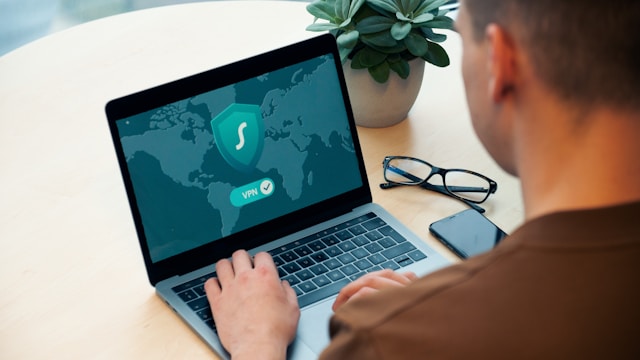- Change theme
Cybersecurity: Defenses Against Growing Digital Threats

Explore the best cybersecurity strategies & defenses designed to protect against the increasing range of digital threats.
01:19 19 December 2024
Cybersecurity is essential for protecting private information, businesses, and individuals from growing online threats in the modern digital age. Businesses, including online casinos, such as Vulkan Bet, strive to guarantee the feeling of safety to customers. Cyberattacks become incredibly sophisticated due to people’s increasing reliance on the Internet and digital technology.
As hackers continue to devise new ways to exploit holes, cybersecurity is not just for big companies but everyone on the Internet. In this post, we will explore the ever-growing dangers of digital technology and what we can do to guard against them.
The Growing Threat Landscape
Several digital threats can injure data integrity, security, and privacy. The most common types of cyberattacks include:
- Malware: Worms, viruses, ransomware, spyware, and other malicious programs that penetrate and infect systems. Ransomware has grown in popularity in the past few years as hackers seize access to your systems and ask for money to retrieve your data;
- Phishing: In most phishing attempts, fake emails or websites inflate users into giving away personal data (such as credit card numbers, usernames, and passwords);
- Denial of Service (DoS) Attacks: Such attacks overwhelm a network or system and render it unusable. In DDoS attacks, the network is bombarded with failing traffic from various systems;
- Social Engineering: Hackers often rely on psychological pressure or human error to persuade users to divulge private information. Making yourself appear as a trusted individual can also be employed to gain access to systems or secure locations;
- Data Breaches: When financial or personal data is exposed by unauthorized use of information, most often through hacking, it constitutes a data breach. Since it robs identities and damages businesses, this could be a serious matter for individuals and companies.
Understanding the Cruciality of Cybersecurity
Effective cybersecurity is more important than ever. The increasing usage of cloud services, the global expansion of remote work, and networked gadgets (IoT) have all opened up new layers of risk. Most estimates now calculate that cybercrime will devastate the global economy by trillions of dollars, and attacks will become more frequent as technology advances.
Cybersecurity protects privacy, security, and data integrity, as well as preventing financial harm. This data is particularly valuable at a time when so much of our personal, economic, and work lives happen online. If you don’t want to face a breach's consequences, ensure all users, small businesses, and enterprise companies implement a comprehensive cybersecurity plan.
Cybersecurity Defenses: How to Protect Against Digital Threats
You can implement different protective tactics and best practices to defend against escalating cyber attacks. They include organizational techniques, technical equipment and personal attention to detail. Some of the most common defences include the following:
- Firewalls;
- Encryption;
- Multi-Factor Authentication (MFA);
- Antivirus and Anti-malware Software;
- Regular Software Updates;
- Security Awareness Training.
Firewalls
The firewall isolates an untrusted external network, such as the Internet, from a secure internal network. It keeps track of incoming and outgoing connections, both malicious and legitimate, and allows them. Firewalls can meet any company's or individual's security needs and are essential to preventing unauthorized access to internal systems.
Encryption
Encrypting data and turning it into a cryptographically secure form will prevent anyone from accessing it. It protects private data both in transit and in the cloud. For example, your credit card or personal details are encrypted when you use online banking or shopping portals, making it harder for hackers to spy on and abuse you.
Multi-Factor Authentication (MFA)
As users are prompted to verify multiple identities before being allowed to access accounts or resources, MFA provides an added layer of security. It usually comprises three: something you own (a security token or phone), something you know (a password), and something you are (a fingerprint or facial recognition). Even when a password is lost, MFA eliminates unauthorized access.
Antivirus and Anti-Malware Software
These tools track and remove malicious software, such as viruses, spyware, and ransomware. They are essential for shielding PCs and smartphones from common attacks. Antivirus programs should continually be updated as new threats emerge daily.
Regular Software Updates
Many hacks exploit the vulnerabilities of old software. By regularly patching known security holes, known vulnerabilities are fixed by updating software, operating systems, and applications. It’s why most companies provide automatic updates, but individuals and organizations need to look out for the upgrades and roll them out as soon as possible.
Security Awareness Training
Telling individuals about potential threats is one of the best ways to guard against attacks from the Internet. It also helps employees or users who receive security awareness training recognize social engineering, phishing attacks, etc. Adding cybersecurity to the culture helps employees spot threats and avoid costly errors.
Securing Your Digital World: Effective Defenses for the Future
At a time when digital threats are more common than ever, cybersecurity is essential to protect people and organizations. Innovative tools, proactive security, and increased awareness can mitigate the risks of malware, hackers, and other cyber attacks.
As technology evolves, so should our approach to cybersecurity. To ensure secure and safe online communities, it’s essential for every individual, business, or institution to be aware, follow best practices, and keep up with emerging issues. If we do, we can ensure our digital future and bolster our security against the growing cyber threat.
